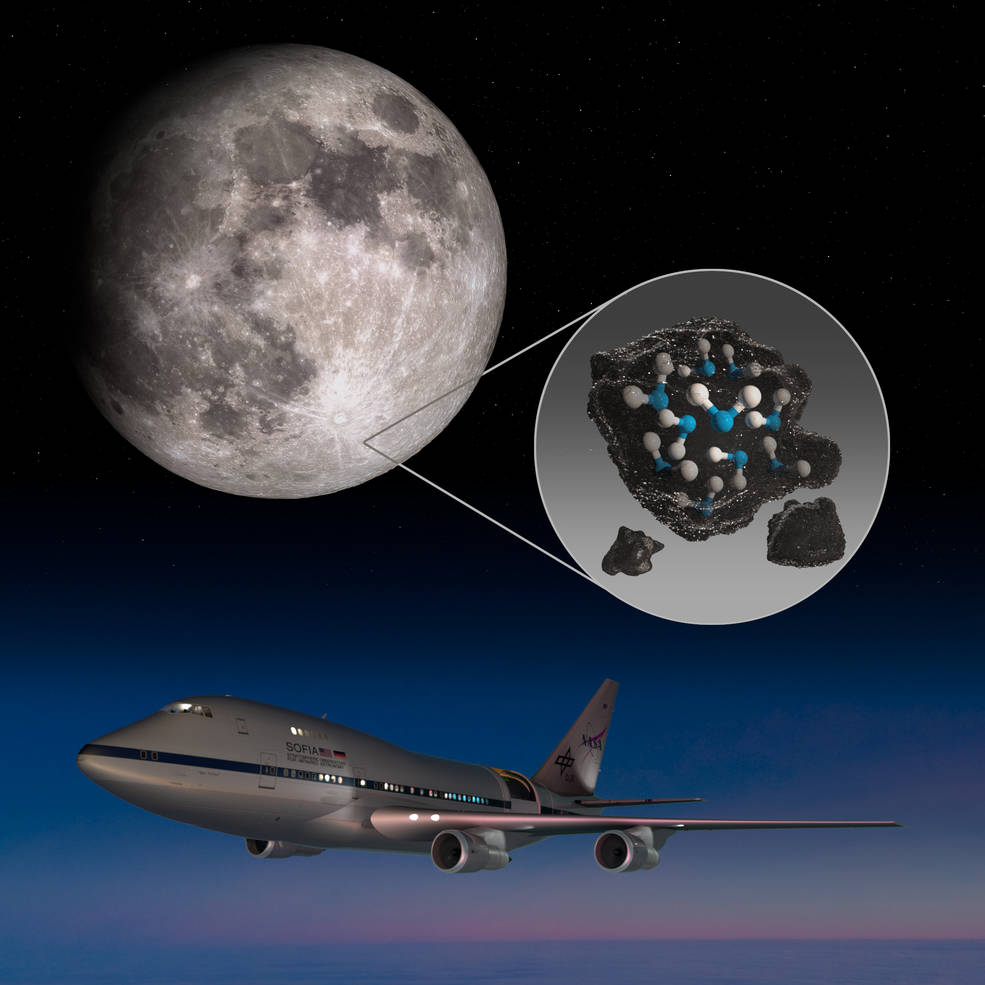HOUSTON, TX – NASA’s Stratospheric Observatory for Infrared Astronomy (SOFIA) has confirmed, for the first time ever, water on the sunlit surface of the Moon. This discovery indicates that water may be distributed across the lunar surface, and not limited to as previously thought, cold, shadowed places.
Recently, SOFIA has detected water molecules (H2O) in the 'Clavius Crater', one of the largest craters on the moon visible from Earth, which is located in the Moon’s southern hemisphere. Previous observations of the Moon’s surface have detected some form of hydrogen, but scientists were unable to distinguish its identity between water and it's close chemical relative, hydroxyl (OH).
Data from this location reveal water in concentrations of 100 to 412 parts per million, or roughly equivalent to a 12-ounce bottle of water, trapped in a cubic meter of soil spread across the lunar surface. These results have been published in the latest issue of Nature Astronomy here.
“We had indications that H2O, the familiar water we know, might be present on the sunlit side of the Moon,” said Paul Hertz, director of the Astrophysics Division in the Science Mission Directorate at NASA Headquarters in Washington. “Now we know it is there. This discovery challenges our understanding of the lunar surface and raises intriguing questions about resources relevant for deep space exploration.”
For comparison, the Sahara desert has approximately 100 times the amount of water than what SOFIA detected in the lunar soil. Despite the finding of small amounts of water, this discovery raises several new questions about how water is created and how it persists on the harsh, airless lunar surface.
As we know water is a precious resource in deep space and a key ingredient of life as we know it, whether the water SOFIA found is easily accessible for use as a resource remains to be determined at this time. Under NASA’s Artemis research program, the agency is eager to learn all it can about the presence of water on the Moon in the advance of sending the first woman and next man to the Moons surface in 2024 and establishing a sustainable human presence there by the end of the decade.
SOFIA’s results build on years of extensive research examining the presence of water on the Moons surface. When the Apollo astronauts first returned from the Moon in 1969, it was thought to be completely dry entirely.
Orbital and impactor missions over the past 20 years, for instance NASA’s Lunar Crater Observation and Sensing Satellite, confirmed ice in permanently shadowed craters around the Moon’s poles. Meanwhile, several spacecraft, including the Cassini Mission and Deep Impact Comet Mission, as well as the Indian Space Research Organization’s Chandrayaan -1 Mission, and NASA’s ground-based Infrared Telescope Facility, looked widely across the lunar surface and found evidence of hydration in many sunnier regions. However, those missions were unable to definitively distinguish the form in which it was present, either H2O or OH.
“Prior to the SOFIA observations, we knew there was some kind of hydration,” said Casey Honniball, the lead author who published the results from her graduate thesis work at the University of Hawaii at Mānoa in Honolulu. “But we didn’t know how much, if any, was actually water molecules – like we drink every day – or something more like drain cleaner.”

Pictured: Illustration of NASA’s SOFIA (modified 747) which recently discovered the presence of water on sunlit surfaces of the Moon.
SOFIA has offered a new means of observing at the Moon, flying at altitudes of up to 45,000 feet, this modified Boeing 747SP jetliner with a 106-inch diameter telescope reaches above 99% of the water vapor in Earth’s atmosphere to get a clearer view of the infrared universe.
Using its Faint Object infraRed Camera for the SOFIA Telescope (FORCAST), SOFIA was able to pick up the specific wavelength unique to water molecules, at 6.1 microns, and discovered a relatively surprising concentration in the sunny Clavius Crater.
“Without a thick atmosphere, water on the sunlit lunar surface should just be lost to space,” said Honniball, who is now a postdoctoral fellow at NASA’s Goddard Space Flight Center in Greenbelt, Maryland. “Yet somehow we’re seeing it. Something is generating the water, and something must be trapping it there.”
Several factors could be at play in the delivery or creation of this water accumulation. Micrometeorites raining down on the lunar surface, carrying small amounts of water, could potentially be depositing the water on the lunar surface upon impact.
However, another possibility is there could be a two-step process where the Sun’s solar wind delivers hydrogen particles to the lunar surface, causing a chemical reaction with oxygen-bearing minerals in the soil to create hydroxyl. At the same time, radiation from the bombardment of micrometeorites could be transforming that hydroxyl into water.
How the water then gets stored, making it possible to accumulate, also raises some intriguing questions for researchers. The water could be trapped into tiny beadlike structures in the soil that form out of the high heat created by micrometeorite impacts, or another possibility is that the water could be hidden between grains of lunar soil and sheltered from the sunlight, potentially making it a bit more accessible than the water trapped in the beadlike structures.
For a mission designed to look at distant, dim objects such as black holes, star clusters, and galaxies, SOFIA’s spotlight on Earth’s nearest and brightest neighbor was a slight detour from the typical business as usual.
Telescope operators typically use a guide camera to track stars, keeping the telescope locked steadily on its observing target, but the Moon is so close and bright that it fills the guide camera’s entire field of view. With no stars within the camera's visibility, it was unclear if the telescope could reliably track the Moon. To determine this, in August 2018, the operators decided to attempt a test observation.
“It was, in fact, the first time SOFIA has looked at the Moon, and we weren’t even completely sure if we would get reliable data, but questions about the Moon’s water compelled us to try,” said Naseem Rangwala, SOFIA’s project scientist at NASA's Ames Research Center in California's Silicon Valley.
“It’s incredible that this discovery came out of what was essentially a test, and now that we know we can do this, we’re planning more flights to do more observations.”
SOFIA’s follow-up flights will begin to look for water in additional sunlit locations and during different lunar phases to learn more about how the water is being produced, stored, and moved across the Moons surface. The data accumulated will add to the work of future Moon missions, such as NASA’s Volatiles Investigating Polar Exploration Rover (VIPER), to create the first water resource maps of the Moon for future human space exploration.
In the same issue from Nature Astronomy, scientists have published findings using theoretical models and NASA's Lunar Reconnaissance Orbiter data, noting that water could potentially be trapped in small shadows, where temperatures stay below freezing across more of the Moons surface than currently expected. These findings and results can be found here.
“Water is a valuable resource, for both scientific purposes and for use by our explorers,” said Jacob Bleacher, the chief exploration scientist for NASA’s Human Exploration and Operations Mission Directorate. “If we can use the resources at the Moon, then we can carry less water and more equipment to help enable new scientific discoveries.”
SOFIA is a joint project of NASA and the German Aerospace Center. Ames manages the SOFIA program, science, and mission operations in cooperation with the Universities Space Research Association, headquartered in Columbia, Maryland, and the German SOFIA Institute at the University of Stuttgart. The aircraft is maintained and operated by NASA’s Armstrong Flight Research Center Building 703, in Palmdale, California.
Subscribe to the LIVE! Daily
Required






Post a comment to this article here: